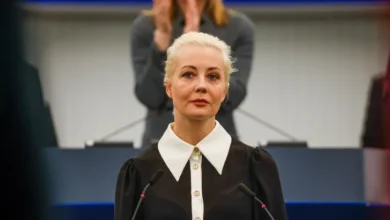Boeing CEO acknowledges mistakes, says mid-air blowout ‘can never happen again’

Boeing CEO Dave Calhoun publicly acknowledged that the company had made mistakes following last week’s mid-air panel blowout on a full Alaska Airlines flight, saying it would work with regulators to make sure it “can never happen again.”
The statements are the first public acknowledgment of errors by the planemaker several days after the incident.
“We’re going to approach this number one acknowledging our mistake,” Calhoun told employees, according to an excerpt released by Boeing. “We’re going to approach it with 100 percent and complete transparency every step of the way.”
He also employees the company will make sure “ensure every next airplane that moves into the sky is in fact safe.” Calhoun praised the Alaska Airlines crew that swiftly moved to land the 737 MAX 9 plane Friday after a panel was ripped off as it climbed out of Portland, Oregon with a full complement of passengers on board.
It has refocused investor and regulatory attention on Boeing’s difficult last few years after a pair of crashes in 2018 and 2019 that killed nearly 350 people.
The company has suffered from numerous production issues since the wider grounding of the 737 MAX family in March 2019 that lasted 20 months.
The US Federal Aviation Administration grounded a total of 171 planes on Saturday after the incident, causing numerous flight cancellations. The panel that blew off Alaska Air Flight 1282 replaces an optional exit door used by airlines that have denser seating configurations.
Alaska Airlines and the other US 737 MAX 9 operator, United Airlines, both said on Monday they had found loose parts on multiple grounded aircraft during preliminary checks, raising new concerns among industry experts about how Boeing’s best-selling jet family is manufactured and its approval process.
A source told Reuters that United Airlines discovered that “closer to 10 than five” aircraft had loose parts used to fasten a panel that exists in lieu of an exit door on certain 737 MAX models.
The planes have not yet started official inspections of their grounded aircraft. Boeing was still working out inspection guidelines for to ensure safety lapses are fixed after airlines found several aircraft with loose parts.
The US Federal Aviation Administration said on Tuesday afternoon that Boeing was revising its instructions for inspections and maintenance, which the FAA must still approve before checks can begin on the 171 grounded planes. The FAA said it “will conduct a thorough review” and public safety will “determine the timeline” for returning the MAX to service.
Boeing shares fell 1.4 percent Tuesday.
Industry insiders said airlines have started to hear passengers voice concerns about the safety of the aircraft, even though the MAX 9 in question is used only by a handful of carriers.
Boeing hit revised sales goals in 2023, saying on Tuesday it had delivered 528 planes and booked 1,314 net new orders – the latter a 70 percent increase from the year-earlier period. However, the company still faces an aggressive timetable for production and it had hoped to resume deliveries to China, a giant market that has been closed to Boeing since 2019.
The US FAA could also take a harder line on certifying designs for other models, including required changes to the MAX 7. Boeing wanted an exemption to allow certification before the design changes that analysts say is much less likely now.
FAA head Mike Whitaker, who took the job in October, will testify before Congress next month, according to sources, where he could face questions about the regulator’s role in the approval of the 737 MAX planes. The hearing was in the works before the incident on the Alaska Airlines flight.
The FAA continues to inspect each new 737 MAX before an “airworthiness certificate is issued and cleared for delivery,” when it typically delegates the final sign-off on individual airplanes to the manufacturer. The FAA did not directly answer questions about how it typically inspects those bolts before approving a plane for service.
The panel that blew off Alaska Air Flight 1282 replaces an optional exit door used by airlines that have denser seating configurations. It is fastened in place by fittings at 12 different locations along the side of the plug and the door frame. The Alaska Air plane’s panel was recovered on Sunday by a Portland schoolteacher who found it in his backyard.
The National Transportation Safety Board “has not yet recovered the four bolts that restrain it from its vertical movement,” NTSB engineer Clint Crookshanks told reporters at a briefing in Portland. “And we have not yet determined if they existed there.”
As of midday on Tuesday, United had canceled around 200 daily flights, or 8 percent of its total, while Alaska canceled 108, or 18 percent.










